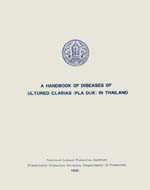
CULTURED CLARIAS (PLA DUK) IN THAILAND
 |
A HANDBOOK OF DISEASES OF CULTURED CLARIAS (PLA DUK) IN THAILAND |
Hyperlinks to non-FAO Internet sites do not imply any official endorsement of or responsibility for the opinions, ideas, data or products presented at these locations, or guarantee the validity of the information provided. The sole purpose of links to non-FAO sites is to indicate further information available on related topics.
This electronic document has been scanned using optical character recognition (OCR) software. FAO declines all responsibility for any discrepancies that may exist between the present document and its original printed version.
Chapter 1 THE CULTURED CLARIIDS
Chapter 2 HUSBANDRY OF CLARIAS IN RELATION TO DISEASE
Chapter 5 WATER MANAGEMENT FOR DISEASE CONTROL
Chapter 6 PROPHYLAXIS AND THERAPY
APPENDIX 1 CONVERSION OF UNITS
6 EXAMPLES IN DISEASE TREATMENT
This handbook is a result of a programme of close collaboration between scientists in the National Inland Fisheries Institute1, Department of Fisheries, Thailand and the Institute of Aquaculture2, University of Stirling. It was made possible by the support of FAO/UNDP as part of the Pond Management Techniques and Disease Control Project (THA/75/012) which was established by the United Nations Development Programme in association with the Royal Thai Government. The Thai clarias culture industry has already developed to a remarkable degree. It is hoped that this book may help to enable this success to be enhanced even further, but it must be emphasis that the industry is very young and scientific study of the diseases found in clarias culture is even younger. It is likely that in the future many more conditions will come to light which will require study, and treatment. This handbook represents a first overview of the subject - we have much more to learn.
The authors would like to thank Mr. Vanich Vareekul, Director of the National Inland Fisheries Institute, and all of our colleagues in both Institutes for their assistance throughout both the survey work and the production of this handbook.
The programme would have been impossible without the generous support of FAO/UNDP and of the Royal Thai Government. The work of the Institute of Aquaculture is supported by the Overseas Development Administration of the British Foreign and Commonwealth Office whose help is also gratefully acknowledged.